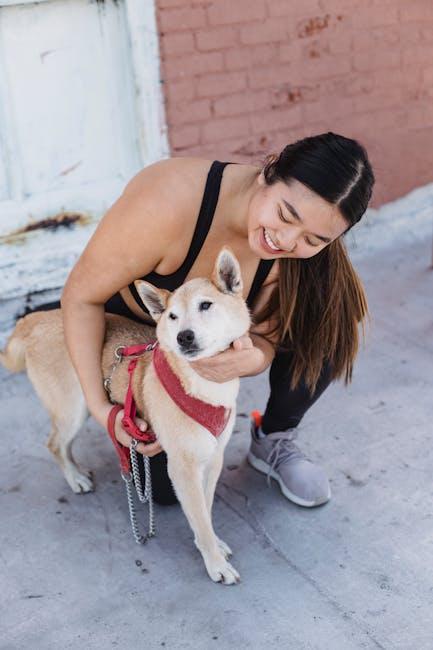Introducing your dog to the world of leash walking is a rewarding journey that strengthens your bond and opens up new avenues for exploration and adventure. Whether you’re strolling through a bustling city or meandering along a tranquil forest path, teaching your dog to walk confidently on a leash is an essential skill that ensures safety and enhances your shared experiences. In this guide, we’ll walk you through the process with patience and positivity, offering tips and techniques to help your furry friend master the art of leash walking. Embrace this opportunity to learn and grow together, transforming each walk into a delightful adventure for both you and your beloved companion.
Choosing the Right Equipment for Your Dogs Comfort
Ensuring your furry friend is comfortable while learning to walk on a leash is essential for a positive training experience. Begin by selecting a collar or harness that fits snugly yet comfortably. A harness is often a better choice for smaller breeds or dogs prone to pulling, as it distributes pressure more evenly across their body. Ensure that the material is soft yet durable, and consider options with padding for extra comfort.
When it comes to the leash, choose one that provides a balance between control and freedom. A standard 4 to 6-foot leash is ideal for training, allowing you to guide your dog without too much slack. Look for features such as a comfortable grip and sturdy clip. Reflective materials can also be beneficial for visibility during early morning or evening walks. Remember, your dog’s comfort is crucial to making leash training an enjoyable and stress-free activity.
- Opt for a harness for better control and comfort.
- Choose a leash with a comfortable grip and appropriate length.
- Consider reflective materials for added safety.
- Ensure all equipment is made from soft, durable materials.

Building Trust and Confidence with Gentle Leash Introduction
Introducing your furry friend to a leash can be a pivotal moment in your training journey. Start by selecting a comfortable and lightweight leash that doesn’t overwhelm your dog. Allow your pup to explore the leash by leaving it on the floor, letting them sniff and get accustomed to its presence. This gentle introduction fosters curiosity and reduces anxiety, setting a positive foundation for leash training.
- Positive Reinforcement: Reward your dog with treats and affection when they show interest in the leash.
- Short Sessions: Begin with brief interactions, gradually increasing the time as your dog becomes more comfortable.
- Patience is Key: Some dogs may take longer to adjust, so maintain a calm and encouraging demeanor throughout the process.
Creating a positive association with the leash from the start builds trust and confidence, ensuring that your dog sees it as a tool for adventure rather than restraint. This gentle approach lays the groundwork for a lifelong enjoyment of walks together.

Step-by-Step Guide to Teaching Loose Leash Walking
Embarking on the journey to teach your furry friend to walk beside you with a relaxed leash can be a rewarding experience. Begin by choosing a comfortable collar or harness that fits snugly but isn’t too tight. Ensure your dog is in a calm state before starting your walk; this sets the tone for a positive session.
- Start Indoors: Begin training in a distraction-free environment. This helps your dog focus solely on you and the task at hand.
- Reward the Calm: Use treats or verbal praise when your dog walks with a loose leash. This reinforces the behavior you want to see.
- Be Consistent: Consistency is key. Practice daily, even if it’s just for a few minutes, to build a habit.
- Stay Patient: Progress may be slow at first. Celebrate small victories and remain patient as your dog learns.
Remember, the goal is to create a positive association with the leash and walking experience. If your dog pulls, stop walking and wait for them to return to your side before continuing. This teaches them that pulling will not get them where they want to go. With time and dedication, your walks will become an enjoyable and peaceful part of your daily routine.
Addressing Common Challenges and Celebrating Success
Training your dog to walk on a leash can sometimes feel like a Herculean task, but with patience and the right techniques, you can transform those challenges into successes. Common challenges you might face include pulling, fear of the leash, and distraction by surroundings. To address pulling, practice stopping immediately when your dog pulls, resuming only when the leash is slack. If your dog fears the leash, introduce it gradually as a positive object by associating it with treats and affection. For easily distracted dogs, carry their favorite treats or toys to redirect their focus back to you.
- Patience is Key: Take small steps and celebrate each little victory with your pup.
- Positive Reinforcement: Reward good behavior consistently to encourage repetition.
- Consistency: Practice regularly to instill good habits.
As you overcome these hurdles, remember to celebrate successes—no matter how small. Successfully walking past a barking dog or ignoring a tempting squirrel are achievements worth acknowledging. Each success builds your dog’s confidence and strengthens your bond, making walks more enjoyable for both of you. Celebrate with praise, a treat, or a fun play session at the end of the walk to reinforce the positive experience.

